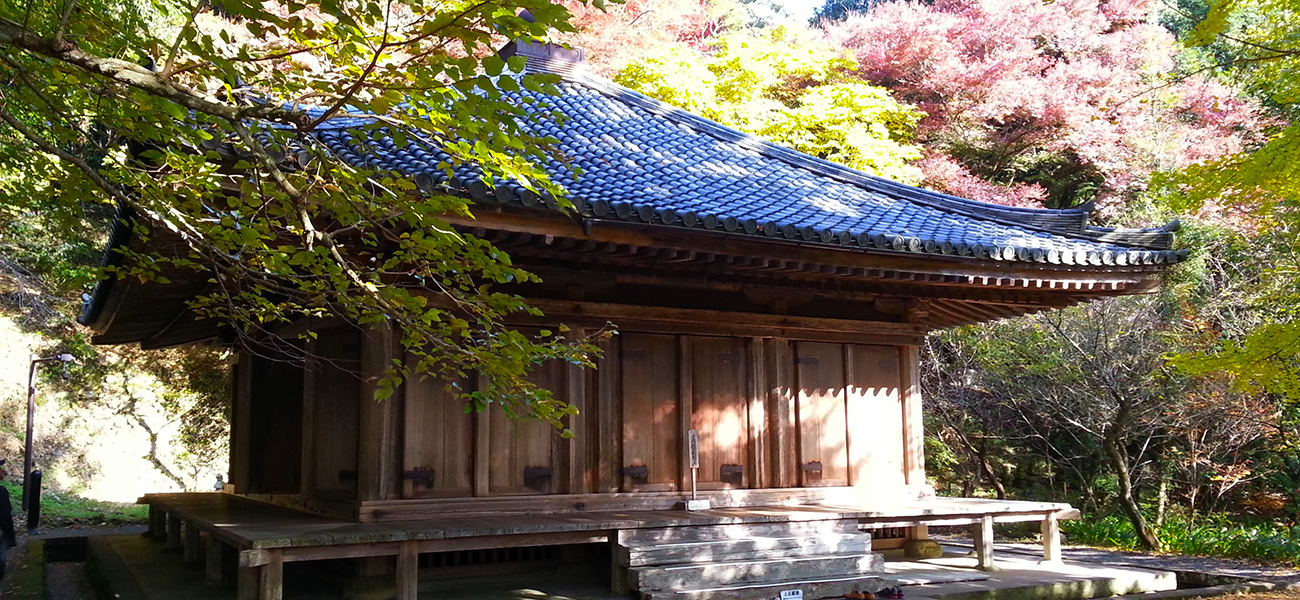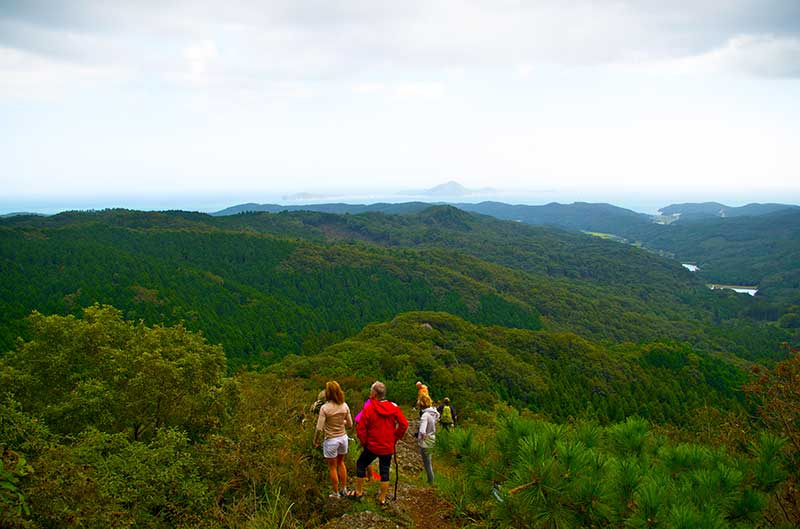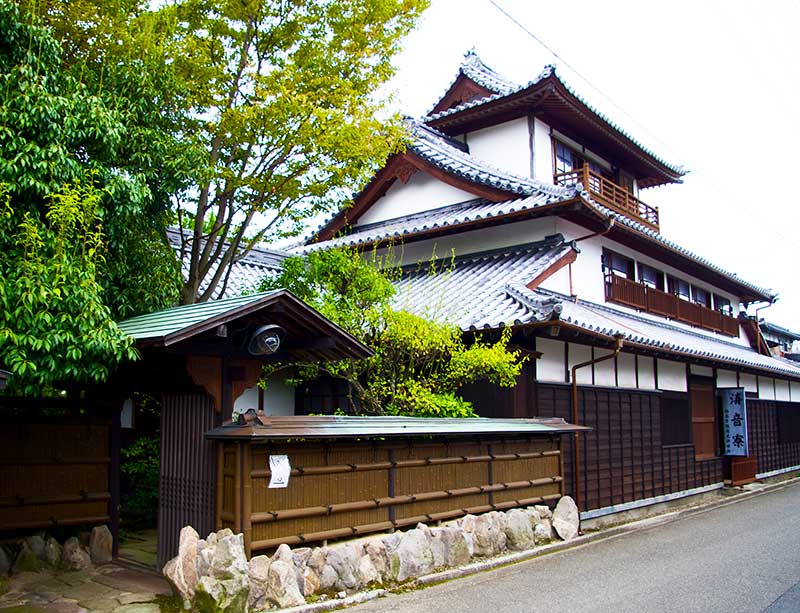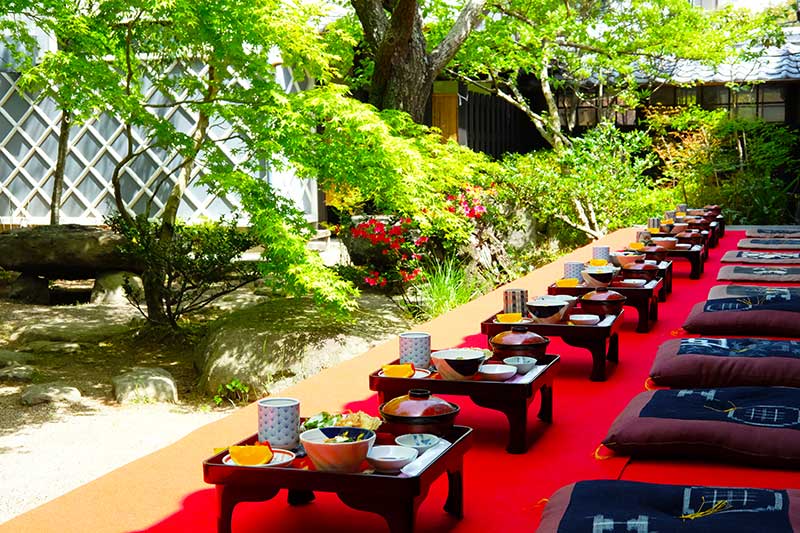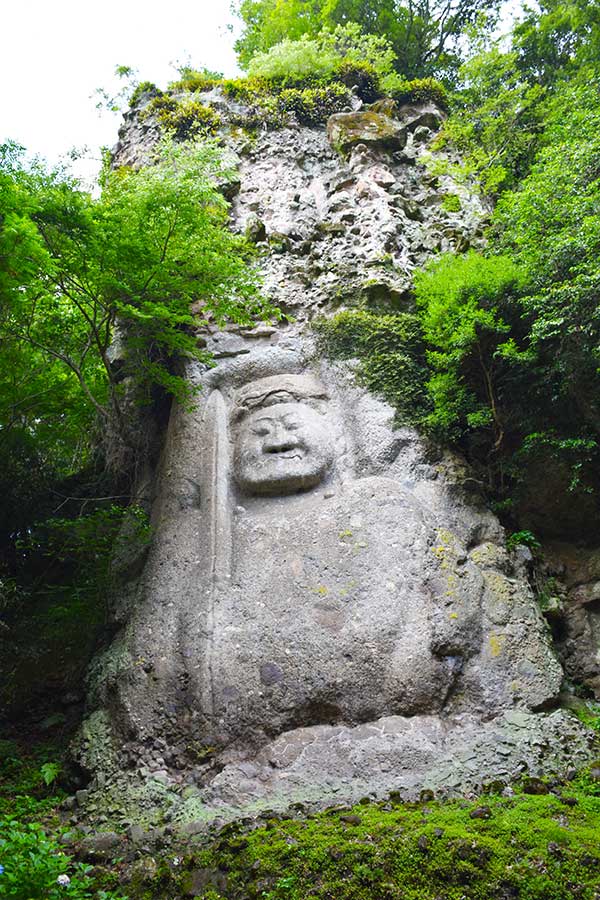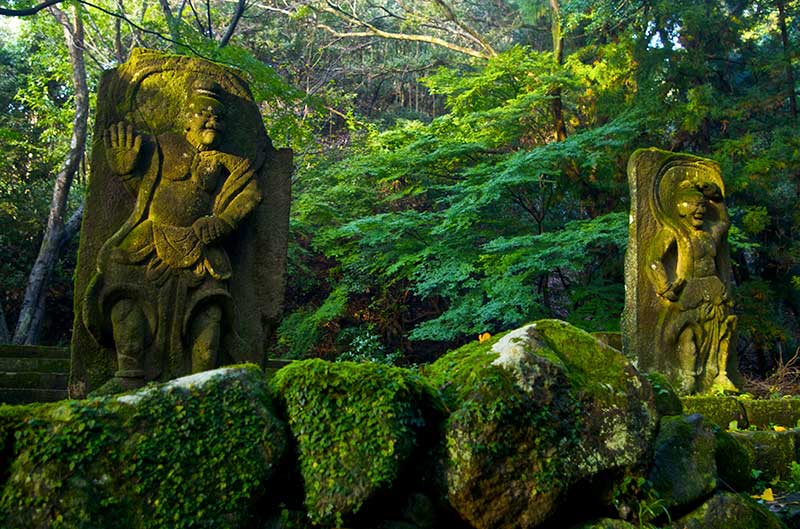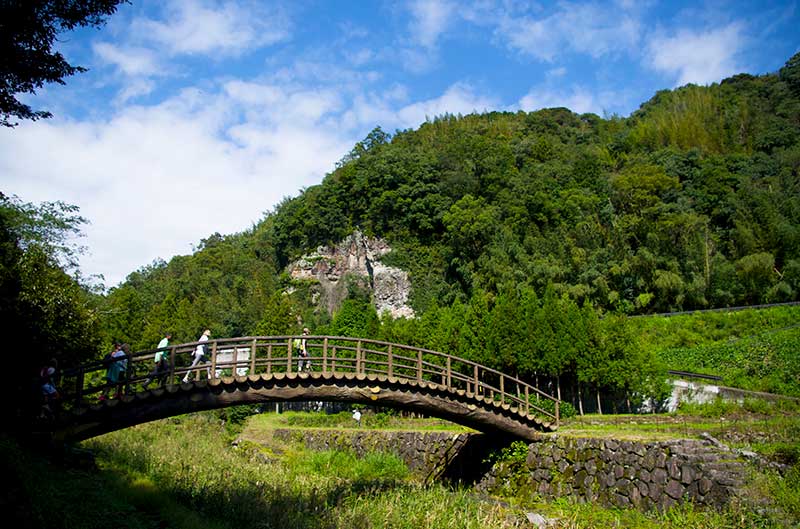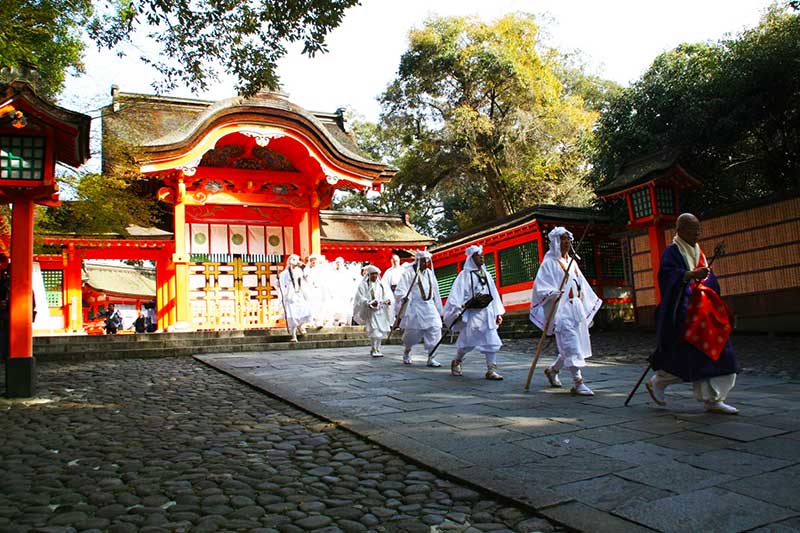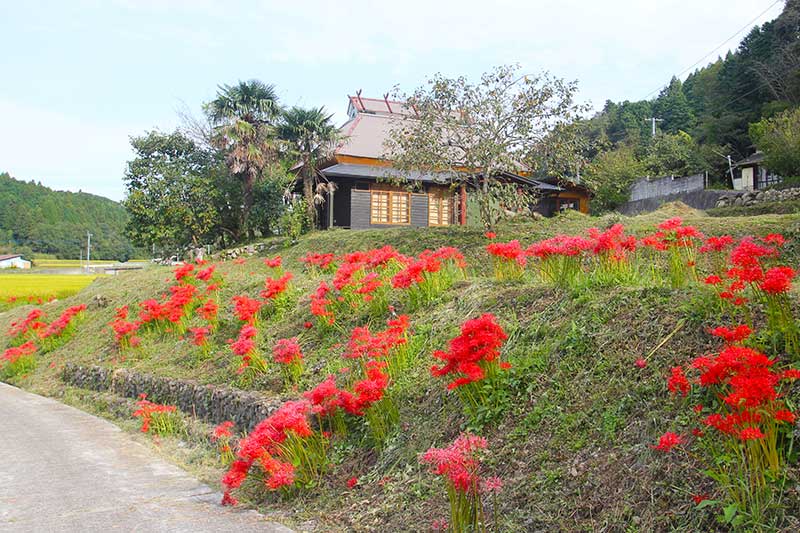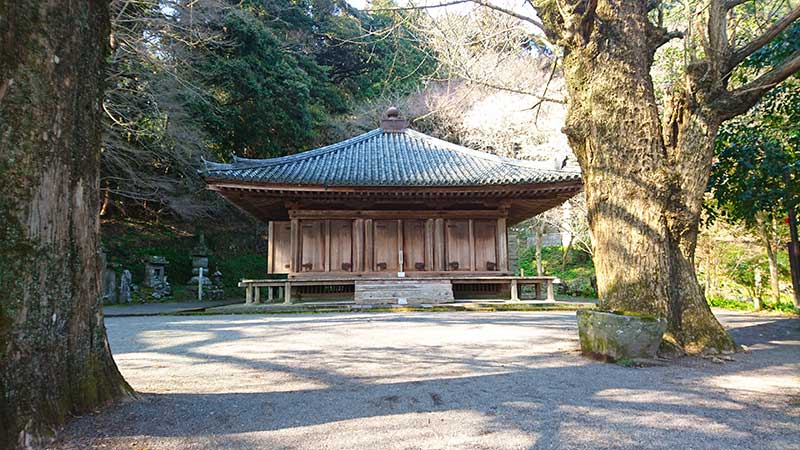A walking tour following paths once trod by monks in Kyushu.
Guided walking exploration, a gentler and shorter version of Walk Japan’s Kunisaki Trek tour. Easy walks through beautiful rural scenery, dotted with the relics of a once dominant Buddhist society; charming local inns, farmhouse cuisine, onsen thermal hot spring baths.
March - June & September - December.
A 5-day, 4-night tour starting at Nakatsu Station and finishing at Yufuin. Accommodation is in Japanese inns with onsen thermal hot spring baths. Please read more on accommodation here. The maximum group size for this tour is 12 persons. We have no minimum size. If we accept a booking we guarantee to run the tour.
This short-stay, fully-guided tour provides an introduction to Kunisaki Peninsula, one of Japan’s most beautiful yet least known areas, and nearby Yufuin, one of Japan’s elegant onsen thermal hot spring resorts. Our route follows in the footsteps of monks, who have walked the mountains of the peninsula for over 1,200 years. Any experienced trekker will thoroughly enjoy the ancient trails, which provide excellent walking through sleepy hamlets and verdant forests, along craggy ridges towering over the myriad surrounding valleys. En route we pass many stone Buddha statues, large and small, and sometimes caves where monks once found shelter and meditated. As with all our tours, on the Kunisaki and Yufuin Walk you will be immersed in Japanese culture of the past and present, enjoy Japanese cooking at its best, luxuriate in hot springs and simply gaze at the beautiful scenery. All this, of course, is with the expert guidance of your Walk Japan tour leader.
The tour starts at 3:15pm at Nakatsu Station, where your Walk Japan tour leader meets the group. We are then transferred by a private vehicle into the rural interior of Kyushu and the Kunisaki Peninsula, a beautiful and seemingly forgotten area of Japan. We stay on the peninsula for three nights at two different delightful inns, each with its own onsen thermal hot spring baths. An added bonus at one is the adjacent Fuki-ji temple, home to one of Japan’s most beautiful temple structures. Besides enjoying reviving dips in our accommodation's onsen, the meals our inn provides are a feast of locally sourced ingredients contrived into dishes of delicacy and great flavours.
This tour provides a gentle walking introduction to Kunisaki: we visit Usa Jingu, one of the greatest but least known of Japan’s grand shrines; walk through Tashibu, a lovely village in a bucolic setting; make a short but steep climb to two ancient Buddha relief carvings on the face of a towering cliff. We also climb to Itsutsuji-Fudo, the inner sanctum and one of the few structures to remain of a once important and powerful temple. As we climb, great views open up of the surrounding mountains and valleys and on a clear day we can see the Seto Inland Sea, the route by which Buddhism first arrived in Kunisaki from China, and Japan’s main island, Honshu. Other walks take us through Walk Japan’s community project, which is successfully helping to revive a local rural community; and to Kitsuki, a quiet town that was once the seat of the local samurai baron.

Day 1 Nakatsu - Yabakei
The tour group meets at 3:15pm at Nakatsu Station in Oita Prefecture.
From Nakatsu we then travel 30 minutes by private-hire vehicle to Yabakei, where we stay the night in the surroundings of a delightful onsen inn. Yabakei is known for its picturesque valleys, verdant forests, sparkling streams and, of course, its many onsen thermal hot springs.
After checking in, we have time to immerse ourselves in the onsen baths. Refreshed, we enjoy a sumptuous welcoming banquet.
Accommodation: Modern Japanese inn with onsen hot spring baths.
Meals: Dinner provided.
Total walking: N/A.
Total elevation gain: N/A.
Day 2 Yabakei – Usa – Makiodo – Fuki-ji
For those awake early enough, a dip in the onsen baths is a great way to start the day. Breakfast is followed by a short vehicle transfer to Usa Jingu, one of Japan’s grandest shrines. It is also one of the most important as it serves as the head shrine deifying Hachiman, the protector god of the nation. Usa Jingu was also instrumental in the development of the distinctively different Buddhism found on the neighbouring Kunisaki Peninsula.
From here we transfer to the impressive Kumano Magaibutsu. The largest Buddha relief carvings in Japan, they are little-known outside of the immediate region. Perhaps the short but steep climb through a deep forest to see them precludes visits by many. The effort, though, is well worth it.
Nearby is Makiodo, a rather basic temple building that has become a treasure house of Buddhist relics saved from some of the temples that have, over the centuries, fallen into ruin on Kunisaki. A gentle stroll from here takes us through Tashibu-no-sho, a charming village with some of the most picturesque countryside found in Japan. Along the way we come across stone and wooden Buddhist statues perched in caves overlooking farmland scenery that seems to have changed little since Kunisaki’s origins as a Buddhist centre some 1,200 years ago.
We end the day at a Japanese inn set in a delightful rural hamlet and adjacent to Fuki-ji, a temple that includes one of the simplest and most beautiful Buddhist structures in Japan. Once again, our inn has onsen baths to relax in before dinner, a feast of local fish and farm produce. We stay here for two nights.
Accommodation: Modern Japanese inn.
Meals: Breakfast, lunch & dinner provided.
Total walking: 7km (4.3miles) / 3 hours.
Total elevation gain: 276m (905ft).
Day 3 Fuki-ji – Coton-mura – Kyu-Sento-ji – Fuki-ji
Breakfast is followed by a visit to Fuki-ji temple, immediately adjacent to our accommodation. Its main building is a simple, refined wooden structure, undoubtedly one of the most beautiful in Japan. We soak up the serene atmosphere here before transferring to Coton-mura, a lakeside park, where we begin our hike today.
Our walk takes us past the dam holding back the lake, through forest and a quiet hamlet. This is followed by a climb up and around the side of Yayama, an imposing tent-shaped mountain, to Choan-ji, at one time the most powerful temple in Kunisaki. A castle once dominated the area high above on Mt. Yayama, and the well-tended garden is renowned in the area for its flowers, which bloom throughout the year, as well as its autumn leaves.
After lunch, a quick visit to Tennen-ji temple. The last resident priest has long gone but the locals maintain the thatched main building that is built into the side of a high cliff.
We continue to the grounds of Kyu-Sento-ji, a once-powerful temple. Little now remains of the temple buildings but stone Buddha statues, impressive stone walls and hundreds of monks’ gravestones allude to the long-disappeared religious community. The gravestones include that of Ninmon, the legendary monk reputed to have brought Buddhism to Kunisaki over 1,200 years ago. We climb to Itsutsu-ji Fudo, a small temple structure set into the side of a giant rock outcrop. On a clear day, from here we enjoy views across Kunisaki to the Seto Inland Sea and beyond to Honshu and Shikoku, respectively Japan’s first and fourth main islands.
We return to our accommodation at Fuki-ji for a second night.
Accommodation: Modern Japanese inn.
Meals: Breakfast, lunch & dinner provided.
Total walking: 7km (4.3 miles) / 3.5 hours.
Total elevation gain: 445m (1,460ft).
Day 4 Fuki-ji – Ota – Kitsuki – Yufuin
This morning we travel by vehicle a short distance through valleys at the heart of Kunisaki to visit Ota and Walk Japan’s Community Project. We stroll through a delightful, quiet rural district on old trails, past farmhouses, kitchen gardens, paddy fields and through forests for an intimate exploration of rural life in modern Japan. Please read more about our project here.
We then set off for Kitsuki, once the seat of Kunisaki’s daimyo baron. Now a quiet, elegant town, Kitsuki still retains an air of its feudal past, and is a pleasant place to enjoy lunch.
In the afternoon, we stroll through the streets of Kitsuki to a lovely and rare bukke-yashiki, a thatched-roofed building that was formerly the residence of a senior samurai aide to the daimyo. Time permitting, we also visit some long-established emporiums in the town, sampling the local produce as we do so.
Finally, we transfer to Yufuin, one of Japan’s elegant onsen towns. We spend our last night together here in a modern ryokan inn. There may not be much time to dip in our inn’s onsen before dinner – the Japanese enjoy dinner earlier rather than later – but there is plenty of time to do so later as they are open throughout the night.
Accommodation: Modern Japanese inn with onsen hot spring baths.
Meals: Breakfast, lunch & dinner provided.
Total walking: 5.5km (3.4 miles) / 2 hours.
Total elevation gain: 84m (280ft).
Day 5 Yufuin
The tour finishes in Yufuin after breakfast but you may want to spend some time here exploring on your own. Nestled into the lee of Mt. Yufu-dake, the town, with its elegant cafes and shops, provides a pleasant way to wind down before departure. Travel back to Hakata Station or Fukuoka Airport by direct express coach or onward travel elsewhere in Japan by air and rail is easily accomplished. Your Walk Japan tour leader will assist in the purchase of your tickets and make sure you know what to do to complete your journey without a problem.
Accommodation: N/A.
Meals: Breakfast provided.
Total walking: N/A.
Total elevation gain: N/A.
This itinerary is subject to change.
The airports closest to the tour’s start at Nakatsu Station are Fukuoka International Airport and Oita Airport, with domestic flights departing frequently from Tokyo and Osaka’s airports.
-----
BY AIR
FROM FUKUOKA INTERNATIONAL AIRPORT (FUK)
From Fukuoka International Airport, take the City Subway line to Hakata Station, which takes approximately 5 minutes. Alternatively, the journey by taxi takes approximately 15 minutes. From Hakata Station follow the travel by rail instructions below.
FROM OITA AIRPORT (OIT)
From Oita Airport, travel to Nakatsu either by taxi, or by bus. Please note that the latter runs only four times each day.
-----
BY RAIL
FROM HAKATA STATION
Travel by the JR Sonic Express train to Nakatsu Station. The journey takes approximately 1 hour and 20 minutes.
FROM KOKURA STATION
Travel by the JR Sonic Express train to Nakatsu Station. The journey takes approximately 30 minutes.
-----
The pre-tour pack includes detailed instructions, including a map, for travel to the accommodation at the start of the tour.
Tour participants are strongly advised not to book themselves out on a morning flight at the end of the tour, as the journey from Yufuin to the nearest international airport is approximately 2 hours.

